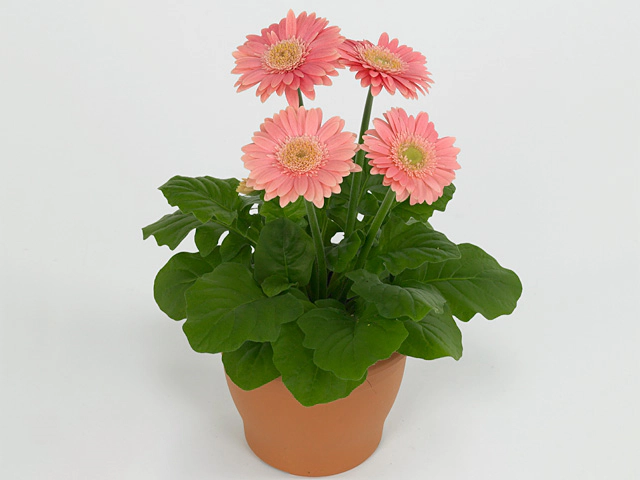Gerbera Durora Rose

| Flower type | Slightly doubled |
| Leaf margin | Lobed |
| Winter hardness | Not hardy (USDA-zone 9,10,11) |
| Flower color | Pink-pink-048D |
| Soil fertility | No special demands |
| Leaf, general shape | Elliptic / oval |
| Flower diameter | 7 - 7,5 cm |
| Plant height | 10 - 20 cm |
| Inflorescence | Capitulum (head) |
| Leaf size | 7,5 - 10 cm |
| Light conditions | Semi-shades; Sunny |
| Leaf, main color | Dark green |
| Flower color distribution | Unicolored |
| Moisture requirements | Normal; Moist |
| Soil type | Humus rich; Peaty |
The Gerbera Durora Rose, also known as the Transvaal Daisy, is a beautiful flower that adds a touch of elegance to any garden or floral arrangement. With its slightly doubled flower petals and lobed leaf margins, it is truly a unique and eye-catching plant.
Although it is not considered hardy in most regions, the Gerbera Durora Rose thrives in USDA zones 9, 10, and 11. This means that it prefers milder climates with warmer temperatures. To ensure its survival during the colder months, it is recommended to provide protection or bring the plant indoors.
One of the standout features of this flower is its stunning pink-pink color, known as pink-048D. This vibrant hue adds a burst of joy and femininity to any landscape. Whether planted in the ground or displayed in a pot, the Gerbera Durora Rose is sure to attract attention with its captivating color.
When it comes to soil fertility, this particular flower has no special demands. It can grow well in various types of soil, as long as it is not excessively sandy or clayey. Adding organic matter, such as compost or well-rotted manure, to the soil can enhance its fertility and provide the necessary nutrients for healthy growth.
The leaves of the Gerbera Durora Rose have an elliptic or oval shape and a dark green color, which serves as a striking contrast to the vibrant pink flowers. The leaves can reach a size of 7.5 to 10 cm, adding a lush and full appearance to the plant.
In terms of light conditions, the Gerbera Durora Rose prefers semi-shaded areas or areas with direct sunlight. It can adapt to both and will thrive as long as it receives an adequate amount of light. Placing it in a location where it can receive a few hours of sun each day is ideal for optimal growth and blooming.
With regards to moisture requirements, this flower is quite versatile. It can tolerate both normal and moist conditions, meaning it can withstand periods of drought as well as wetter conditions. However, it is important to ensure proper drainage to prevent waterlogging, as this can lead to root rot and other issues.
The Gerbera Durora Rose prefers soil that is humus-rich and peaty. These types of soil provide the necessary nutrients, moisture retention, and drainage for the plant to flourish. Adding organic matter and regularly replenishing the soil's nutrients can help maintain its health and vitality.
In conclusion, the Gerbera Durora Rose, or Transvaal Daisy, is a stunning flower with its slightly doubled petals and lobed leaf margins. While it may not be hardy in all regions, it thrives in USDA zones 9, 10, and 11. Its pink-pink-048D color, combined with its dark green leaves, adds a touch of elegance to any garden. With no special demands for soil fertility and the ability to tolerate various light and moisture conditions, this flower is relatively easy to care for. Planting it in humus-rich, peaty soil and providing adequate light and drainage will ensure its health and allow it to display its full beauty.
Market availability index by month:
| Jan. | Feb. | Mar. | Apr. | May | Jun. | Jul. | Aug. | Sep. | Oct. | Nov. | Dec. |
|---|---|---|---|---|---|---|---|---|---|---|---|
| - | - | - | 2 | 4 | 4 | 1 | - | - | - | - | - |